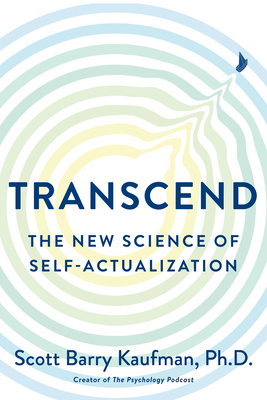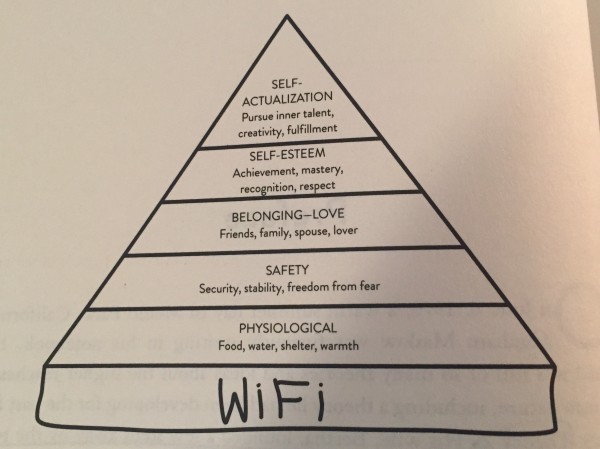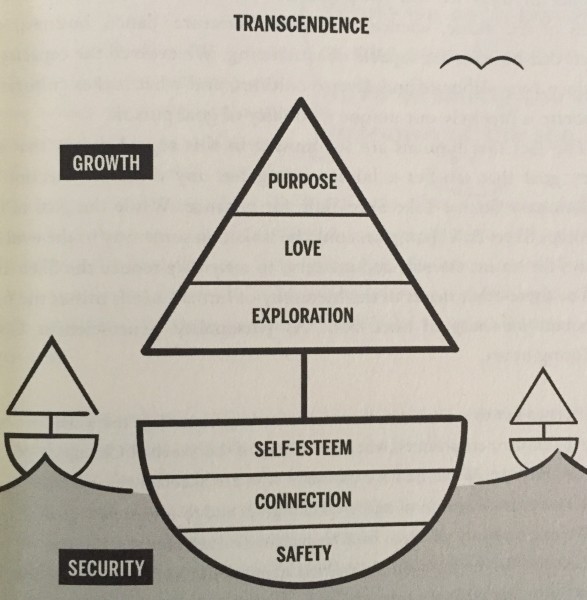Review: Scott Barry Kaufman’s “Transcend”
by Miles Raymer
In 2020––a year painfully riddled with death, loss, and uncertainty––cultivating our capacities for compassion, love, and flourishing seems both harder and more necessary than ever. In this crucial project, I can think of no better text to guide us than Scott Barry Kaufman‘s Transcend. This enlightening and joyous voyage into humanity’s psychological history, present, and possible futures arrived at exactly the right moment––not just for me personally, but for all of us.
First and foremost, Kaufman’s aim is to promote the field of humanistic psychology by revisiting and upgrading the work of Abraham Maslow. Maslow’s “hierarchy of needs,” which was later turned into a pyramid “by a management consultant in the sixties” (xxix), became famous as a way of understanding both the bare necessities of healthy living as well as “higher” modes of being such as self-actualization. Here’s Kaufman’s cheeky reproduction:
Kaufman’s research reveals that, toward the end of his life, Maslow realized that self-actualization wasn’t the upper limit of human potential, and “became convinced that healthy self-actualization is actually a bridge to transcendence” (xiv, emphasis his). Maslow set to work articulating this new outlook, which he called “Theory Z,” but his work was cut short due to poor health and a premature death in 1970. “So the thought is,” Maslow wrote less than three years before his passing, “save it all in little memos in these journals & the right person to come will know what I mean & why it must be done” (xvii, emphasis his). Discovering this type of mission from the past is every academic’s dream, and Kaufman goes above and beyond the call of duty. This razor-sharp, assiduously-cited, and reader-friendly compilation of contemporary psychological insights is an elegant tribute to Maslow and his fellow humanistic psychologists.
Kaufman’s starting point is to examine how best to get people to live more in what Maslow called the “Being-Realm,” or “B-realm” for short. This is accomplished primarily by approaching life with a mindset focused on growth rather than deficiency:
The Being-Realm of existence…is like replacing a clouded lens with a clear one. Instead of being driven by fears, anxieties, suspicions, and the constant need to make demands on reality, one is more accepting and loving of oneself and others. Seeing reality more clearly, growth-wisdom is more about “What choices will lead me to greater integration and wholeness?” rather than “How can I defend myself so that I can feel safe and secure?” (xxxi)
Kaufman suggests that thinking about one’s life journey as a sailboat cutting across a vast ocean can help us access the B-realm with more consistency and ease:
As you can see, the sailboat is comprised of two separate sections: the boat, which represents security (our universal needs for safety, connection, and self-esteem), and the sail, which represents growth (our unique capacities for exploration, love, and purpose). In Kaufman’s own words:
Life isn’t a trek up a summit but a journey to travel through––a vast blue ocean, full of new opportunities for meaning and discovery but also danger and uncertainty…The boat itself protects us from seas that are rarely as calm as we’d like. Each plank of the boat offers security from the waves. Without it, we’d surely spend all our energy trying to stay above water…Having a secure boat is not enough for real movement, however. You also need a sail…Each level of the sail allows you to capture more wind, helping you explore and adapt to your environment. Note that you don’t “climb” a sailboat like you’d climb a mountain or a pyramid. Instead, you open your sail, just like you’d drop your defenses once you felt secure enough. This is an ongoing dynamic: you can be open and spontaneous one minute but can feel threatened enough to prepare for the storm by closing yourself to the world the next minute. The more you continually open yourself to the world, however, the further your boat will go and the more you can benefit from the people and opportunities around you. (xxxii-xxxiii, emphasis his)
This metaphor, much richer and more accurate than Maslow’s original hierarchy or the pyramid that followed, is the best method I’ve ever encountered for visualizing humanity’s basic needs and potentialities. Above the sailboat hovers transcendence, a tantalizing possibility for the grandest states of well-being and consciousness. Kaufman explains:
If you’re truly fortunate, you can even enter ecstatic moments of peak experience––where you are really catching the wind. In these moments, not only have you temporarily forgotten your insecurities, but you are growing so much that you are helping to raise the tide for all the other sailboats simply by making your way through the ocean. In this way, the sailboat isn’t a pinnacle but a whole vehicle, helping us to explore the world and people around us, growing and transcending as we do. (xxxiii, emphasis his)
From this point, Kaufman provides a thorough and fascinating tour of the sailboat and various pathways to oceanic transcendence. As I read, I often found myself imagining the self as a crew of hearty and intrepid sailors, each diligently tending to the sailboat’s intricate and equally-important facets. A truly magnificent sailboat, I think, would sport a crew working in perfect synchrony––a merry transcendance that allows them to explore new horizons, support shipwrecked or stranded companions, and weather even the toughest storms. Here’s Kaufman’s definition:
Healthy transcendence is an emergent phenomenon resulting from the harmonious integration of one’s whole self in the service of cultivating a good society. This view of transcendence, which I believe is the healthiest form of transcendence, is not about leaving any parts of ourselves or anyone else behind or singularly rising above the rest of humanity. Healthy transcendence is not about being outside of the whole, or feeling superior to the whole, but being a harmonious part of the whole of human existence. It’s all of humanity. In a nutshell: healthy transcendence involves harnessing all that you are in the service of realizing the best version of yourself so you can help raise the bar for the whole of humanity. (218)
Pretty words, eh? I can hear you, cynical reader, scoffing at such sugar-coated fluffery. I did my fair share of scoffing, but each time found my criticism tempered by Kaufman’s uplifting blend of relentless positivity and unflinching realism. He doesn’t downplay or ignore the dark side of human nature, nor does he deny that destructive environmental conditions can nullify even the noblest attempts at self-betterment.
To help readers build the best sailboats they can, Kaufman presents oodles of empirically-supported advice on the best ways to become a “whole” or “fully-integrated” person, which he defines as “an ongoing journey of discovery, openness and courage, in which you reach higher and higher levels of integration and harmony within yourself and with the outside world, allowing greater flexibility and freedom to become who you truly want to become” (257, emphasis his). Here are what I found to be his most memorable points:
- Be confident in your “right to shine,” and take responsibility for it (71)
- Understand and integrate your personal motivations (85)
- Incorporate new information and experiences via healthy exploration (93)
- Treat traumatic experiences as irreversible tragedies that nevertheless offer opportunities for learning and growth (103-4)
- Practice balanced coordination between three important brain networks: default mode, executive attention, and salience (116)
- Embrace “dichotomy-transcendence,” an intellectual state in which “ordinary dichotomies…are no longer seen as dichotomies but are all seen as simply parts of a larger integrated whole” (117, 225-6)
- Assert your agency (personal needs and goals) while also seeking outlets for communion (contributions to family/community/society) (126-7, 169-70)
- Cultivate the four facets of the “quiet ego”: detached awareness, inclusive identity, perspective-taking, and growth-mindedness (134-5)
- Embody “whole love” through integrating your need for individuality with your need for connectedness, including sexual passions (139, 145)
- Strive for clearly-articulated and well-integrated goals that are aligned with your personal values and aspirations (160-2)
- “Quick hits” of transcendence via peak experiences aren’t useful when disconnected from “the hard work of inner integration,” and can even be damaging (215)
- Avoid “us vs. them” or “good vs. evil” thinking. Instead, be realistic about the significant limitations of human nature, and practice compassion and forgiveness with yourself and others (240-1)
- Create and sustain “plateau experiences” that intentionally infuse vivid perceptions of ordinary life with sacredness and a healthy acknowledgment of mortality (242)
- Learn to see self-actualization as consonant with improving the lives of others and the world in general (243-4)
In addition to these suggestions, Kaufman includes two appendices directly focused on helping readers understand themselves and grow intentionally in the directions they desire. Here are a few of my favorite passages from Appendix I, “Seven Principles for Becoming a Whole Person”:
While the true self may be a convenient fiction, I truly believe that there are, within each of us, aspects of our self that are most conducive to health and growth as a whole person. I believe we each have best selves––aspects of who we are that are healthy, creative, and growth-motivated–– that make us feel most connected to ourselves and to others. The more we can drop our social facades and the defenses that we erect to protect ourselves, the more we open ourselves up to greater opportunities for growth, development, and creativity. (260)
If sometimes it feels as though there are multiple personalities within you that are constantly warring with one another, well, that’s because there are multiple personalities within you that are constantly warring with one another! Each of us contains a bundle of dispositions, emotional tendencies, values, attitudes, beliefs, and motives that are often contradictory and incompatible…Given the brains we have, and our unique capacity for awareness of the often bewildering outputs arising from the complex computations of our brains, we actually do a pretty great job of managing our inner conflicts. To be sure, at times reality can feel unbearable, and despite the general satisfaction most people feel with their lives, mental illness is actually a lot more common than people realize. In fact, most people develop a diagnosable mental illness at some point in their lives. Nevertheless, most people report being fairly happy in life, show positive developmental change across their life-spans, and display extraordinary capacity for resilience, dignity, and grace. As resilience researcher Froma Walsh puts it, humans have the capacity to “struggle well.” (265-7, emphasis his)
Recent research shows that while enduring personality change isn’t easy, people really can change their personality in very substantial ways throughout life with intentional effort and therapy, as well as by making changes to one’s environment that have long-lasting influences on one’s personality, such as changing one’s job, social roles, or relationship partners, or by adopting new identities…We shouldn’t think of personality as something cast in stone or always consistent. Throughout the course of the day, everyone fluctuates in their personality and even their intellectual functioning quite a lot…Acting out of character is actually quite common…There is nothing sacred or unalterable about being a certain way; with enough adjustments to these patterns over time, we literally change our being. Of course, this doesn’t mean personality change is easy. Trying to change yourself too quickly can be very draining, and you have to want to change. (272-3)
Very simply, and very bravely, Kaufman believes that humans are basically good, worthwhile, and able to improve. He believes this about absolutely everyone. This feature of his worldview shines through on every page of Transcend, making it not only an informative read but also an inspiring and potentially life-changing one.
Rating: 10/10



Thanks for the great review! 🙂
Thanks so much, SBK! I am honored that you took the time to read my review and leave this comment. I also just read Choose Growth, which was a wonderful way to operationalize and build on the research in Transcend. Please keep up the amazing work!